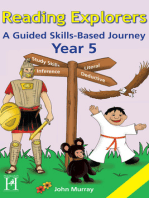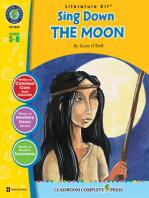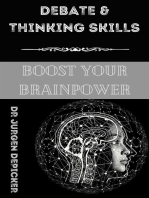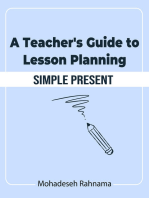Lesson 3
Uploaded by
api-299789918Lesson 3
Uploaded by
api-299789918LESSON PLAN Ref: 3 of 7 Course Ref: Unit 2 of 12
Lesson 3: Exploration of Good and Poor Questions
Subject / Course: English Language Arts/ English 10
Topic: Questioning skills: exploration of good and poor questions.
Lesson Title: Exploration of Good and Poor Questions
Level: Grades 8-11
Lesson Duration: This lesson can be divided into 3 segments
Learning Environment and Technology Utilized:
Blended learning environments. An LMS or CMS, such as edX, could be utilized for the online
components.
Lesson Objectives/ Curricular Competencies:
Respectfully exchange ideas and viewpoints from diverse perspectives to build shared
understanding and extend thinking (ELA: Composition 10)
Apply appropriate strategies in a variety of contexts to comprehend written, oral, visual,
and multimodal texts; guide inquiry; and extend thinking (ELA: New Media 10)
Use writing and design processes to plan, develop, and create engaging and meaningful
literary, imaginative, and informational texts for a variety of purposes and audiences
(ELA: Composition 10)
Reflect on, assess, and refine texts to improve their clarity, effectiveness, and impact
according to purpose, audience, and message (ELA: Composition 10)
Summary of Tasks / Actions:
Explorations of Good and Poor questions. Offline, face-to-face.
The classroom engages in brief reflections about the questioning process yesterday. The
teacher prompts the students by asking questions such as: Do you think you asked the
best questions? Why or why not? Why are questions so important to learning? What is
the relationship between research and questions? What is the relationship between
writing and questions (good writing is a product of answering good questions).
The teacher is to encourage discussion by assigning marks for participation.
The teacher leads the students in determining what characters a good and a poor
question.
A good question helps one understand the text better (students must be able to
explicitly state how a question helps them understand the text); a good question
leads to more good questions; the answer to a good question connects to other
information. Also, for higher level questions, they should be precise, significant,
supportable and debateable. Good questions are always relative to context.
One would not ask higher level questions upon meeting a stranger or as prompt
for a paragraph response.
Introduce students to Blooms Taxonomy. Online.
The teacher will have the students research, and explain, the terms hierarchy and
taxonomy.
The teacher will provide a hard copy of Blooms Taxonomy for each student.
The students will explore what they see/understand from examining the taxonomy. The
teacher may guide the exploration by asking questions such as: How does it compare
with the questioning hierarchy that the students devised? Where did the students go
wrong or right? Why?
The teacher will facilitate an exploration as to what students perceive is the purpose of
the taxonomy.
Introduce students to prompts to use for Blooms Taxonomy. Online (possibly an LMS or CMS
such as edX)
The teacher is to provide a hard/copy, of prompts, for use with Blooms taxonomy, for
each student.
The teacher is to facilitate an exploration as to what students observe about the prompts.
How are they the same/different than the prompts created in their word cloud?
The teacher will model use of prompts with different texts (visual still image, video, written
text, intertextual, multimodal.). The teacher asks one question from each prompt and
explains why it is a good question (i.e how does it help me understand the text? What
other questions does it allude to? What connections can be made with possible answers
to the question? Is it precise, significant, supportable, debatable?).
students are asked to volunteer to supply one question from each prompt, from a
selected resource, (the students are reminded that 10% of their mark is based on
participation).
In edX, or similar CMS, the teacher creates multiple questions and students are asked to
identify which one they think is a good question. Then, they are asked to provide an
explanation as to WHY they think that's a good question (by answering with the
characteristics that denote good questions). Next, they are presented with what their
peers have chosen and their explanations. This allows them to learn from their peers and
see the justification behind it. The last step allows them to see the correct answer and the
instructor's explanation as to why that is the correct answer. They will also be presented
with a histogram of their peers' initial answer choice and final answer choice.
Materials / Equipment:
Teacher must supply hard copy of Blooms Taxonomy and hard copy of questioning
prompts (see Blooms Levels of Questioning and Blooms Levels of Questioning for
English and Socials at the end of the unit).
Teacher must produce materials to model use of prompts with different texts (i.e. visual
still images, video, written text, intertextual, multimodal etc). There is an example
provided, at the end of the unit, entitled Article and Examples for Lesson 3
You might also like
- Child Development Context, Culture, And CascadesNo ratings yetChild Development Context, Culture, And Cascades2,815 pages
- Interacting with Informational Text for Close and Critical ReadingFrom EverandInteracting with Informational Text for Close and Critical ReadingNo ratings yet
- Common Core Snapshot: Administrator's Guide to the Common CoreFrom EverandCommon Core Snapshot: Administrator's Guide to the Common CoreNo ratings yet
- Using Cutting-Edge Technology: Tools to Consider for Enhancing Learning In Grades Six through TwelveFrom EverandUsing Cutting-Edge Technology: Tools to Consider for Enhancing Learning In Grades Six through TwelveNo ratings yet
- Being a 21st Century Educator: Five Trends You Really Want to KnowFrom EverandBeing a 21st Century Educator: Five Trends You Really Want to Know3.5/5 (2)
- Establishing Better Schools: Navigating the Waters of Change (An Introduction to Developing Curriculum)From EverandEstablishing Better Schools: Navigating the Waters of Change (An Introduction to Developing Curriculum)No ratings yet
- Creating Activities for Different Learner Types: A Guide for ELT Teachers, Trainers, and WritersFrom EverandCreating Activities for Different Learner Types: A Guide for ELT Teachers, Trainers, and Writers5/5 (1)
- The Structured Method of Pedagogy: Effective Teaching in the Era of the New Mission for Public Education in the United StatesFrom EverandThe Structured Method of Pedagogy: Effective Teaching in the Era of the New Mission for Public Education in the United StatesNo ratings yet
- Five D’s of Instructional Design: Empowering Student-Centered Learning Excellence: Unveiling the 5 D's Framework for TransformationFrom EverandFive D’s of Instructional Design: Empowering Student-Centered Learning Excellence: Unveiling the 5 D's Framework for TransformationNo ratings yet
- Take Five! for Language Arts: Writing that builds critical-thinking skills (K-2)From EverandTake Five! for Language Arts: Writing that builds critical-thinking skills (K-2)No ratings yet
- Daftar List Ecatalog ABN 2022 With Pict Ok-2No ratings yetDaftar List Ecatalog ABN 2022 With Pict Ok-25 pages
- (Magazine) The Biblical Archaeologist. Vol. 49. No 1No ratings yet(Magazine) The Biblical Archaeologist. Vol. 49. No 170 pages
- Full Download of Test Bank For Child and Adolescent Development in Context, 1st Edition Tara L. Kuther in PDF DOCX Format100% (3)Full Download of Test Bank For Child and Adolescent Development in Context, 1st Edition Tara L. Kuther in PDF DOCX Format37 pages
- (AC-S08) Week 08 - Pre-Task - Quiz - Weekly Quiz - INGLES IV (34349)No ratings yet(AC-S08) Week 08 - Pre-Task - Quiz - Weekly Quiz - INGLES IV (34349)5 pages
- A Summary of The Evidence On Inclusive EducationNo ratings yetA Summary of The Evidence On Inclusive Education40 pages
- Application of Erikson Theory in ClassroomNo ratings yetApplication of Erikson Theory in Classroom7 pages
- Instructions:: 1 9 2 10 3 11 4 12 5 13 6 14 7 15 8 TotalNo ratings yetInstructions:: 1 9 2 10 3 11 4 12 5 13 6 14 7 15 8 Total14 pages
- COT DLP FILIPINO6 - ROMA-Wastong Paggamit NG Pang-Angkop at Pangatnig FINALNo ratings yetCOT DLP FILIPINO6 - ROMA-Wastong Paggamit NG Pang-Angkop at Pangatnig FINAL25 pages
- LP Math 5 Proper and Improper Fraction - 015217No ratings yetLP Math 5 Proper and Improper Fraction - 0152177 pages
- Wang CSPNet A New Backbone That Can Enhance Learning Capability of CVPRW 2020 PaperNo ratings yetWang CSPNet A New Backbone That Can Enhance Learning Capability of CVPRW 2020 Paper10 pages
- A Delve Into Students' Mathematics Anxiety: A Case StudyNo ratings yetA Delve Into Students' Mathematics Anxiety: A Case Study11 pages































































































